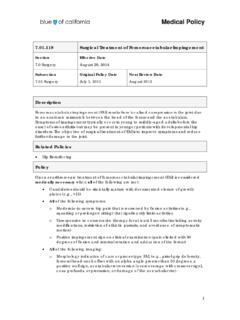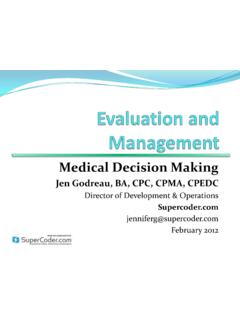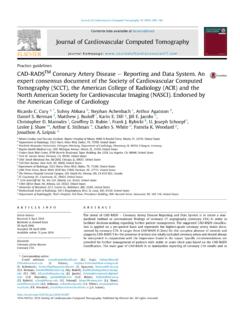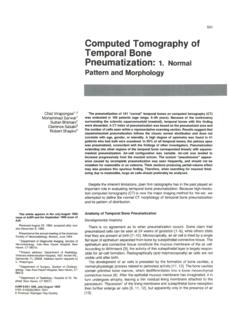Transcription of Reimbursement Policy Computed Tomography (NCD 220.1)
1 Reimbursement Policy Computed Tomography (NCD ) Proprietary information of UnitedHealthcare. Copyright 2014 United HealthCare Services, Inc. Page 1 Policy Number Approved By UnitedHealthcare Medicare Reimbursement Policy Committee Current Approval Date 04/23/2014 IMPORTANT NOTE ABOUT THIS Reimbursement Policy This Policy is applicable to UnitedHealthcare Medicare Advantage Plans offered by UnitedHealthcare and its affiliates. You are responsible for submission of accurate claims. This Reimbursement Policy is intended to ensure that you are reimbursed based on the code or codes that correctly describe the health care services provided. UnitedHealthcare Reimbursement policies use Current Procedural Terminology (CPT *), Centers for Medicare and Medicaid Services (CMS), or other coding guidelines.
2 References to CPT or other sources are for definitional purposes only and do not imply any right to Reimbursement . This Reimbursement Policy applies to all health care services billed on CMS 1500 forms and, when specified, to those billed on UB04 forms (CMS 1450). Coding methodology, industry-standard Reimbursement logic, regulatory requirements, benefits design and other factors are considered in developing Reimbursement Policy . This information is intended to serve only as a general resource regarding UnitedHealthcare s Reimbursement Policy for the services described and is not intended to address every aspect of a Reimbursement situation. Accordingly, UnitedHealthcare may use reasonable discretion in interpreting and applying this Policy to health care services provided in a particular case.
3 Further, the Policy does not address all issues related to Reimbursement for health care services provided to UnitedHealthcare enrollees. Other factors affecting Reimbursement may supplement, modify or, in some cases, supersede this Policy . These factors may include, but are not limited to: legislative mandates, the physician or other provider contracts, and/or the enrollee s benefit coverage documents. Finally, this Policy may not be implemented exactly the same way on the different electronic claims processing systems used by UnitedHealthcare due to programming or other constraints; however, UnitedHealthcare strives to minimize these variations. UnitedHealthcare may modify this Reimbursement Policy at any time by publishing a new version of the Policy on this Website.
4 However, the information presented in this Policy is accurate and current as of the date of publication. *CPT copyright 2010 (or such other date of publication of CPT) American Medical Association. All rights reserved. CPT is a registered trademark of the American Medical Association. Proprietary information of UnitedHealthcare. Copyright 2014 United HealthCare Services, Inc. Table of Contents Application ..1 Summary ..2 Reimbursement Guidelines ..2 CPT/HCPCS Codes ..4 References Included (but not limited to): ..5 CMS NCD ..5 CMS LCD(s) ..5 CMS Article(s) ..5 CMS Benefit Policy Manual ..5 CMS Claims Processing Manual ..6 UnitedHealthcare Medicare Advantage Coverage Summaries.
5 6 UnitedHealthcare Medical Policies ..6 MLN Matters .. 6 Others ..6 History ..6 Application This Reimbursement Policy applies to services reported using the Health Insurance Claim Form CMS-1500 or its electronic equivalent or its successor form, and services reported using facility claim form CMS-1450 or its electronic equivalent or its successor form. This Policy applies to all products, all network and non-network Reimbursement Policy Computed Tomography (NCD ) Proprietary information of UnitedHealthcare. Copyright 2014 United HealthCare Services, Inc. Page 2 physicians, and other health care professionals. The HCPCS/CPT code(s) may be subject to Correct Coding Initiative (CCI) edits.
6 This Policy does not take precedence over CCI edits. Please refer to the CCI for correct coding guidelines and specific applicable code combinations prior to billing UnitedHealthcare. It is not enough to link the procedure code to a correct, payable ICD-9-CM diagnosis code. The diagnosis must be present for the procedure to be paid. Compliance with the provisions in this Policy is subject to monitoring by pre-payment review and/or post-payment data analysis and subsequent medical review. The effective date of changes/additions/deletions to this Policy is the committee meeting date unless otherwise indicated. CPT codes and descriptions are copyright 2010 American Medical Association (or such other date of publication of CPT).
7 All rights reserved. CPT is a registered trademark of the American Medical Association. Applicable FARS/DFARS restrictions apply to Government use. Fee schedules, relative value units, conversion factors, and/or related components are not assigned by the AMA, are not part of CPT, and the AMA is not recommending their use. The AMA does not directly or indirectly practice medicine or dispense medical services. The AMA assumes no liability for data contained or not contained herein. Current Dental Terminology (CDT), including procedure codes, nomenclature, descriptors, and other data contained therein, is copyright by the American Dental Association, 2002, 2004. All rights reserved. CDT is a registered trademark of the American Dental Association.
8 Applicable FARS/DFARS apply. Summary Overview Diagnostic examinations of the head (head scans) and of other parts of the body (body scans) performed by computerized Tomography (CT) scanners are covered if medical and scientific literature and opinion support the effective use of a scan for the condition, and the scan is: (1) reasonable and necessary for the individual patient; and (2) performed on a model of CT equipment that meets the criteria in C below. CT scans have become the primary diagnostic tool for many conditions and symptoms. CT scanning used as the primary diagnostic tool can be cost effective because it can eliminate the need for a series of other tests, is non-invasive and thus virtually eliminates complications, and does not require hospitalization.
9 Reimbursement Guidelines A. Determining Whether a CT Scan Is Reasonable and Necessary Sufficient information must be provided with claims to differentiate CT scans from other radiology services and to make coverage determinations. Carefully review claims to insure that a scan is reasonable and necessary for the individual patient; , the use must be found to be medically appropriate considering the patient's symptoms and preliminary diagnosis. There is no general rule that requires other diagnostic tests to be tried before CT scanning is used. However, in an individual case the contractor's medical staff may determine that use of a CT scan as the initial diagnostic test was not reasonable and necessary because it was not supported by the patient's symptoms or complaints stated on the claim form; , "periodic headaches.
10 " Claims for CT scans are reviewed for evidence of abuse which might include the absence of reasonable indications for the scans, an excessive number of scans or unnecessarily expensive types of scans considering the facts in the particular cases. B. Approved Models of CT Equipment: 1. Criteria for Approval: In the absence of evidence to the contrary, the contractor may assume that a CT scan for which payment is requested has been performed on equipment that meets the following criteria: a. The model must be known to the Food and Drug Administration (FDA), and b. Must be in the full market release phase of development. Should it be necessary to confirm that those criteria are met, ask the manufacturer to submit the information in subsection If manufacturers inquire about obtaining Medicare approval for their equipment, inform them of the foregoing criteria.



















